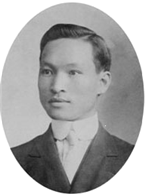Born in Pyongyang, Pyeongnam, he graduated from Soongsil Middle School, a Christian school, and came to the United States in 1903 for the purpose of studying abroad. In 1903, he organized a social club in San Francisco with Ahn Chang-ho and took the lead in the movement to improve the living conditions of the Korean community. In 1905, he worked with Ahn Chang-ho to establish the Korean Public Association in San Francisco, the first ethnic movement organization in the Americas, aimed at anti-Japanese activities and promoting love for fellow Koreans. On December 6, 1906, he founded the Sanghang Korean Methodist Church, where he engaged in relief work, educational enlightenment movements, and job placement for the Korean community.
In 1908, he graduated from Portland Academy in Oregon and became the first Korean to graduate from UC Berkeley in 1916, also attending Pacific School of Religion that same year. He published a church bulletin called “Daedo,” which was the first Korean-language publication in the United States, conveying news about the homeland and global affairs while contributing to Christian evangelism and the education of the Korean community. After the 1906 earthquake devastated San Francisco, he invited Pastor Yang Joo-sam to carry out relief work, educational enlightenment, and health management through the newly opened church. After his successor, Pastor Yoon Byeong-gu, took over the ministry, Lee Dae-Wi (David Lee) became the third pastor on August 3, 1911. This church became a center for worship, fellowship, and patriotic activities.
In February 1909, he played a leading role in the founding of the Korean National Association and was appointed vice president of the North American branch of the association while studying at Berkeley in February 1910. After the annexation of Korea by Japan, he organized the Patriotic Alliance in July of that year and sent a letter to the Japanese emperor strongly opposing the annexation. He worked to establish training camps for independence fighters in various regions and sought to secure necessary resources for the cause. He dedicated himself to providing sponsorship for patriotic figures and Korean students who fled to the United States, acting as a spokesperson for immigration procedures. In 1911, he became the pastor of the Sanghang Korean Methodist Church. He served as president of the North American branch of the Korean National Association three times in 1913, 1915, and 1918, and in June, he became the chief editor of the Shinhan Minbo newspaper.
When Korean laborers were expelled from California due to anti-Asian sentiment, the Japanese consul in the U.S. intervened, promising to resolve labor issues for overseas Koreans. Lee Dae-Wi (David Lee) wrote to the U.S. Secretary of State, requesting that Japan refrain from interfering in the Korean community, and successfully obtained permission for this. In April 1914, the Korean National Association was officially recognized as a legal entity, playing a significant role as a self-governing body for exiles.
The immigration documents of students who entered the U.S. at that time all listed David Lee (Lee Dae-Wi) at 1053 Oak St, San Francisco, as their address. Students were required to show a minimum of $100 in funds and guarantee $50 in monthly financial support. Lee Dae-Wi (David Lee) helped all students who sought assistance. He also sent $50 and letters to those who faced immigration inspection due to illness, requesting that they receive medical treatment and be allowed to enter the country afterward. In March 1915, he personally created Korean phonetic characters and invented the “Intertype Korean Typewriter,” revolutionizing printing in newspapers. This typewriter significantly contributed to the production of the Shinhan Minbo from 1915 to 1970.
During the March 1st Movement in 1919, he served as president of the North American branch of the Korean National Association and actively participated in the declaration of Korean independence. In 1921, he established the Korean Commission in the U.S. with Kim Kyu-sik and Song Heon-joo, dedicating himself to diplomatic efforts and promoting independence. From 1910 to the 1920s, there was hardly anyone in early San Francisco society who did not receive help from Lee Dae-Wi (David Lee), who spent half of his 50-year life with the Korean community in the U.S. He also served as an interpreter for the San Francisco Immigration Office, providing sponsorship for brides arriving without passports through photo marriages and acting as a spokesperson for immigration procedures, officiating at their weddings. During that time, around 500 students studied in San Francisco, including over 70 brides from photo marriages.
Lee Dae-Wi (David Lee) was known for his strong character, determination, and humility. Pastor Song Jeong-ryul of the Sanghang Korean Methodist Church stated that he was as remarkable as Ahn Chang-ho, having served the Korean community and the future of the nation in a practical and direct manner. He passed away from tuberculosis due to overwork on June 17, 1928, just two years before the new church building was completed, at the age of 49. When he was buried at Cypress Cemetery on June 22, 1928, Koreans across the Americas, including those in Mexico and Hawaii, mourned deeply. In 2005, he was interred at the National Cemetery.
In 1995, the government posthumously awarded him the Independence Medal of the Order of National Foundation.

Leave a Reply